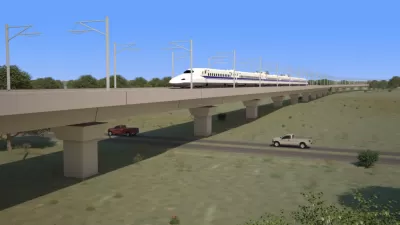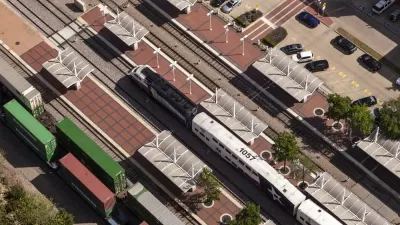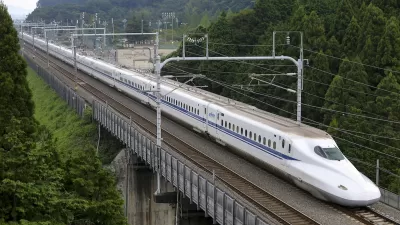The North American High Speed Rail Group has proposed an elevated, $4.2 billion, 150+ mph high-speed rail line above existing highways without public subsidy between Rochester and the Twin Cities. Completion is estimated for 2021.
The private Bloomington-based company, the North American High Speed Rail Group (NAHSR) has completed a preliminary study of a line between Rochester, the state's third largest city (pop. 112,225) and the Twin Cities of Minneapolis and St. Paul, a distance of about 80 miles.
The rail group's study did not reveal any significant problems, reports Heather J. Carlson, Post-Bulletin political reporter.
"Right now, I don't see any final barriers that would stop the project from going forward," Chief Manager Wendy Meadley said.
That's significant because opposition has arisen in Goodhue County. "[T]he county has made their stance very clear with numerous oppositions to the proposed rail line," wrote Gunnar Olson, editor and publisher of the Kenyon Leader on June 27. As is common to these types of large infrastructure projects, a central issue is eminent domain.
In addition, Carlson writes that the "project has faced fierce criticism from some landowners who live along the proposed corridor."
Mazeppa Republican Rep. Steve Drazkowski said he's seen no indication that opposition is dying down.
"The people don't see a need for it," Drazkowski said.
Zip Rail project
The high-speed rail proposal appears to continue what began with Zip Rail, a proposal by the Minnesota Department of Transportation (MnDOT) that would have run in the same 100-mile corridor, left off after MnDOT suspended the project on Jan. 16, although the agency adds that the "NAHSR project is initially much different than the proposed Zip Rail plan."
Private funding a model for U.S. high-speed rail?
The model for the estimated $4.4 billion line that would run from is similar to the privately funded Texas Central high-speed railway linking the 230 miles between the two most populous cities in the Lone State State, Dallas and Houston, in only 90 minutes. That project is estimated to cost $10 billion according to the Texas Department of Transportation. The completion date is projected to be 2021.
NAHSR's Meadley told Reuter's in May, "All the rules relating to public engagement start the day you take public funding."
With private financing, she said, opponents "can't make thousands of public records requests and run the project over."
That comment caught the attention of Bluestem Prairie. "Meadley's hostility to transparency is breathtaking," notes the rural Minnesota blog.
Funds needed
NAHSR "is looking to move to phase two — raising up to $50 million from U.S. investors to fund a detailed feasibility study," adds Carlson for the Post-Bulletin. "The company has recently broadened its money raising efforts, reaching out to investors across the country."
Plus, they are looking abroad.
The company is in negotiations with two countries — China and Japan — over the potential of importing their high-speed rail technology for the project. Representatives from two other countries are flying in to meet with Meadley about the proposal.
Last month, "China Railway, which had agreed to put up $100 million for XpressWest [previously called DesertXpress] to build a 230-mile, 190 mph train from Victorville, Calif. to Las Vegas last September, withdrew from their agreement, primarily due to the inability to use their own trains," notes Planetizen last month.
Like NAHSR, DesertXpress Enterprises, LLC is a private company, but certain federal regulations apply regardless, such as "a federal government requirement that high-speed trains must be manufactured in the United States to secure regulatory approvals," wrote Julie Makinen, a reporter in the Los Angeles Times' Beijing bureau.
Hat tip to National Association of Railroad Passengers Hotline.
FULL STORY: Group pushes ahead with high-speed rail plans

Alabama: Trump Terminates Settlements for Black Communities Harmed By Raw Sewage
Trump deemed the landmark civil rights agreement “illegal DEI and environmental justice policy.”

Planetizen Federal Action Tracker
A weekly monitor of how Trump’s orders and actions are impacting planners and planning in America.

The 120 Year Old Tiny Home Villages That Sheltered San Francisco’s Earthquake Refugees
More than a century ago, San Francisco mobilized to house thousands of residents displaced by the 1906 earthquake. Could their strategy offer a model for the present?

In Both Crashes and Crime, Public Transportation is Far Safer than Driving
Contrary to popular assumptions, public transportation has far lower crash and crime rates than automobile travel. For safer communities, improve and encourage transit travel.

Report: Zoning Reforms Should Complement Nashville’s Ambitious Transit Plan
Without reform, restrictive zoning codes will limit the impact of the city’s planned transit expansion and could exclude some of the residents who depend on transit the most.

Judge Orders Release of Frozen IRA, IIJA Funding
The decision is a victory for environmental groups who charged that freezing funds for critical infrastructure and disaster response programs caused “real and irreparable harm” to communities.
Urban Design for Planners 1: Software Tools
This six-course series explores essential urban design concepts using open source software and equips planners with the tools they need to participate fully in the urban design process.
Planning for Universal Design
Learn the tools for implementing Universal Design in planning regulations.
Clanton & Associates, Inc.
Jessamine County Fiscal Court
Institute for Housing and Urban Development Studies (IHS)
City of Grandview
Harvard GSD Executive Education
Toledo-Lucas County Plan Commissions
Salt Lake City
NYU Wagner Graduate School of Public Service





























